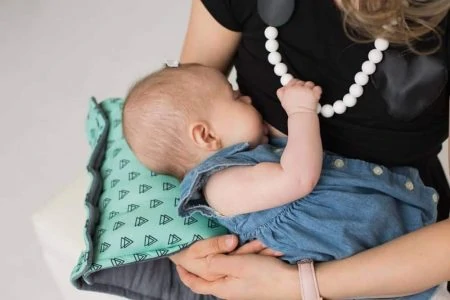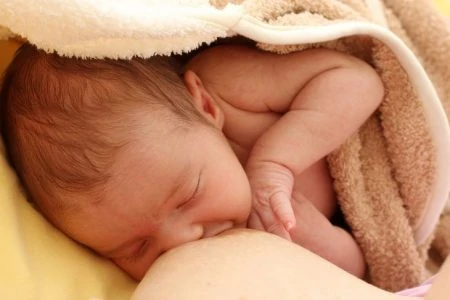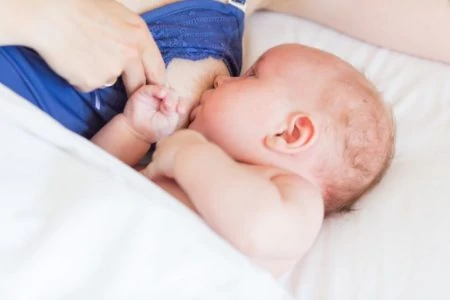The sticker shock is real. However, you do not need to spend a fortune to feed your baby comfortably. We have nursed our way through tight budgets and found the best hacks to help you outfit yourself for less. Here is how to build a functional breastfeeding wardrobe without breaking the bank.
Key Takeaways
- Niche pricing: Nursing clothes cost more because they require specialized materials, complex manufacturing (clips and panels), and lack the mass-market scale of standard womenswear.
- Assess your lifestyle: You don’t need a massive wardrobe. If you stay home often, you can get by with fewer “public-ready” tops and more comfortable loungewear.
- Shop smart: Cut costs by scouring second-hand apps (like Poshmark or ThredUp), using browser extensions for coupons, or borrowing from friends who have weaned their babies.
- DIY and adapt: Convert regular bras into nursing bras, use the “two-shirt method” with existing tank tops, or look for button-downs and wrap dresses already in your closet.
Why Do I Need Nursing Clothes?
Can you survive without specific nursing gear? Technically, yes. But wrestling a standard t-shirt up to your chin while holding a screaming, hungry newborn is stressful. It often leaves your stomach exposed and fabric bunched in the baby’s face.
Nursing clothes solve these problems. They feature discreet panels, clips, or overlaps that allow you to pump or feed without disrobing. This access is a game-changer for nursing in public or during cold weather.
Additionally, nursing tops and bras are engineered for a lactating body. Your breasts will fluctuate in size throughout the day as they fill and empty. Nursing-specific fabrics typically have higher elasticity to accommodate these changes without digging in. Most also feature dedicated space for nursing pads to prevent leak-throughs.
Finally, these clothes serve as a bridge between your maternity wardrobe and your pre-pregnancy size. Despite the stories about breastfeeding melting the pounds away, many women hold onto extra weight until weaning. Nursing clothes are cut to flatter a postpartum figure, offering comfort while you transition.
Keep In Mind
Why Are Nursing Clothes So Expensive?
It comes down to economics and construction. Nursing and maternity clothes are niche markets. Because there are fewer manufacturers compared to standard fast fashion, companies lack the economy of scale to drive prices down.
Construction plays a major role, too. A standard t-shirt is four pieces of fabric sewn together. A nursing top requires complex patterns, hidden layers, modesty panels, zippers, snaps, or plastic clasps. These extra materials and labor hours drive up the manufacturing cost, which gets passed on to you.
How Can I Save Money on Nursing Clothes?
You don’t need a celebrity budget to look good while breastfeeding. With a little strategy, you can build a versatile wardrobe for a fraction of the retail price.
1. Evaluate What You Really Need
Be realistic about your lifestyle. If you are on maternity leave and spending 90 percent of your time at home, modesty panels and zippers might not be necessary. You could easily survive on comfortable loungewear and sleep bras.
If you are returning to an office or are frequently out and about, you will need more structure. However, consider your laundry routine. If you wash clothes twice a week, you only need three or four solid tops on rotation.
Avoid impulse buying a “complete” wardrobe before the baby arrives. Start with the essentials:
- 3 comfortable nursing bras (one on, one in the wash, one spare).
- 2-3 nursing tanks (camis).
- 1-2 pairs of nursing-friendly pajamas.
2. Shop Second Hand
Nursing clothes have a short lifespan. Most women only wear them for six months to a year. This means the secondhand market is full of gently used, high-quality gear. You can often find premium brands for pennies on the dollar.
Where to look:
- Online Resale Apps: Poshmark, Mercari, and ThredUp are goldmines for specific brands.
- Kidizen: While focused on kids, this app has a massive “Mama” section.
- Facebook Marketplace: Great for buying “lots” (bundles) of clothes locally to save on shipping.
- Consignment Sales: “Just Between Friends” or local church sales often have maternity sections.
3. Shop Your Own Closet
Before you buy anything new, raid your pre-pregnancy wardrobe. You likely own “nursing-friendly” clothes without realizing it. Look for items that allow easy access to the breast:
- Button-down shirts: Flannels, denim shirts, or crisp oxfords are perfect.
- Wrap dresses/tops: The V-neck crossover design is easy to pull aside.
- Deep V-necks: Often stretchy enough to pull down.
- Zippered hoodies: A wardrobe staple that works perfectly for nursing.
4. Make Your Own (DIY)
If you are handy with scissors or a needle, you can convert existing clothes into nursing gear. Here are three popular tutorials.
DIY Nursing Bra Conversion
If you have a regular bra that fits well, you can add nursing clasps easily. You will need 3/8″ or 1/2″ nursing clasps (available at fabric stores or Amazon), some elastic, and a needle and thread.
Simple steps:
- Cut the bra strap about one inch above the cup.
- Attach the bottom clasp piece to the top of the bra cup.
- Attach the top clasp piece to the cut strap.
- Sew a piece of elastic or ribbon from the bottom of the strap to the inside base of the cup (this keeps the strap from flying back over your shoulder when unclipped).
No-Sew Nursing Tank
This hack turns an old tank top into a layering piece that attaches directly to your nursing bra.
Instructions:
- Cut the straps off an old tank top.
- Cut a small slit or buttonhole where the strap used to connect to the body of the shirt.
- To wear it, slip the clip of your nursing bra through the hole you cut in the tank top before snapping the bra shut. Now, when you unclip your bra, the tank drops down with it.
Instant Nursing Cover
You don’t need a specialized apron. Any breathable blanket or large muslin swaddle works. Just tie two corners together behind your neck. For a more polished look, you can hem a piece of jersey knit fabric into an infinity scarf that doubles as a nursing cover.
5. Borrow From the “Village”
Maternity and nursing clothes are communal currency. If you have friends who have recently weaned, ask if they have clothes in storage. Most moms are thrilled to clear out the closet space and happy to see their clothes get a second life.
Be sure to clarify if these are gifts or loans. If they are loans, take good care of them and return them washed once you are done.
6. Use Coupons and Cash Back
Never pay full price at major retailers. If you are buying new from places like Old Navy, Gap, or specialized maternity stores, use technology to lower the bill.
- Rakuten (formerly Ebates): Sign up to get automatic cash back on online purchases.
- Honey: This browser extension automatically tests coupon codes at checkout.
- RetailMeNot: Check for in-store barcodes or promo codes before heading to the register.
7. Master the “Two-Shirt Method”
This is the ultimate budget hack. You do not need nursing tops if you utilize layers effectively.
How it works:
- Wear a stretchy camisole or tank top underneath.
- Wear a regular loose shirt (t-shirt, sweater, blouse) over it.
- When it is time to feed, pull the top shirt up and pull the neckline of the camisole down.
This keeps your stomach covered by the camisole and your upper chest covered by the top shirt, leaving only the necessary skin exposed. It turns your entire pre-pregnancy wardrobe into nursing wear instantly.









